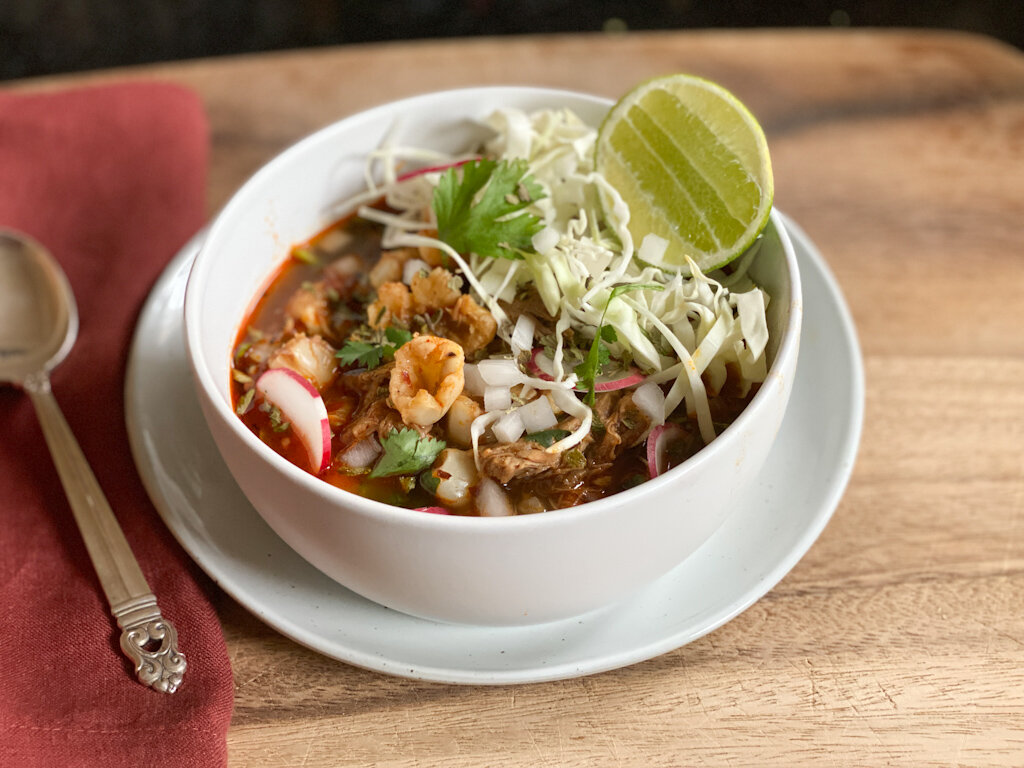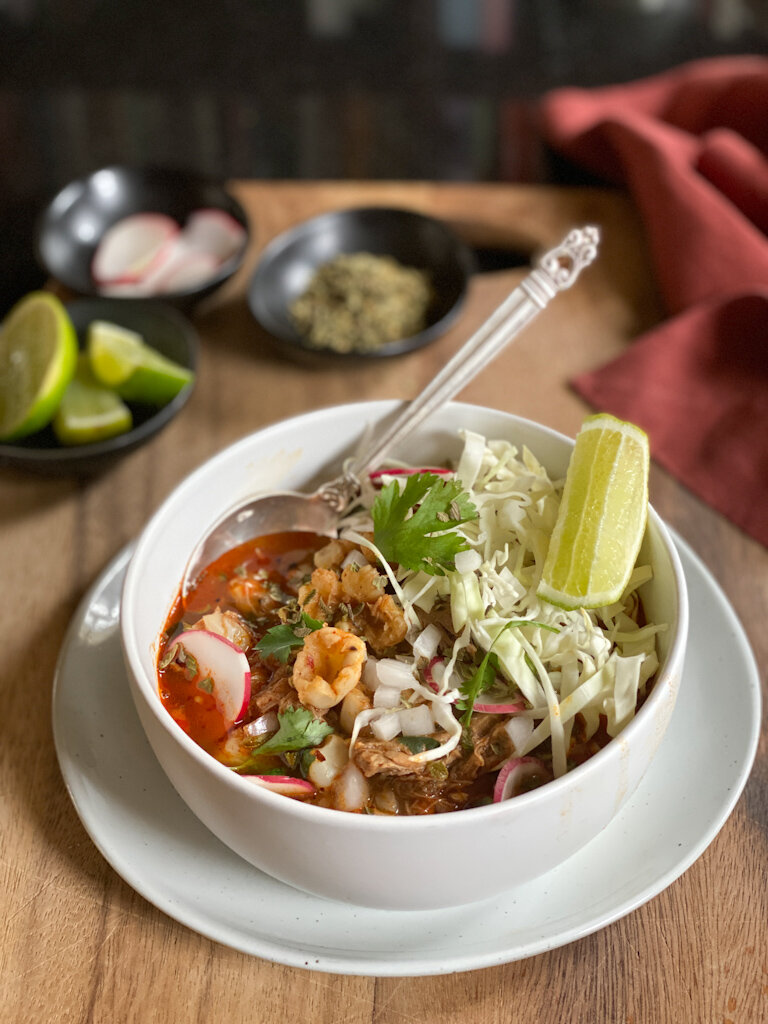Heirloom Pozole Rojo
If you love pozole and you’re serious about Mexican cooking, you need to make pozole at least once in your life starting from dried maize. (If you’re looking for a much simpler recipe using canned hominy, this one’s for you.] There’s a lot of time involved in nixtamalizing the corn, which is achieved by soaking it in an alkaline solution made with “cal" — calcium hydroxide, also known as culinary lime. The alkaline soak softens and loosens the pericarp (outer skin) of each kernel, which will afterward slip off easily. But if you want each kernel to open up and bloom, you’ll also need to remove the cabeza — the pointed germ-end of each kernel. (That’s a step, incidentally, that you’d skip if you were going to finish cooking the corn then grind it to make masa.)
[Read our story “Next-wave masa: A forward-looking purveyor and passionate chefs bring heirloom corn from Mexico to their table and yours.”]
That said, Cooks Without Borders’ Mexican cuisine expert Olivia Lopez suggests making the nixtamal a day in advance and freezing them for easier blooming, even without removing the cabeza. After you cook and steep the grains in the cal solution, then thoroughly rinse them, then freeze them overnight, she says. (We haven’t tested the theory yet; when we do, we’ll update this page.)
Traditionally, pozole rojo is made with a pig’s head. If you want to make that happen in your own kitchen, we commend you (and hope for a dinner invitation!). But for us mortals, outstanding results can be achieved with pork shoulder (also known as Boston butt or pork butt). Once you finish preparing the nixtamal, it’s actually quite a simple dish to prepare.
Note: You’ll want to cut the pork shoulder into four pieces — which won’t be equal because there’s a bone involved. Don’t worry about the size or shape of the pieces; you just want the pieces to be large enough to be easy to retrieve from the stockpot.
Makes about 12 servings.
Ingredients
2 tablespoons plus 3/4 teaspoon cal
1 1/2 pounds maiz cacahuazintle (heirloom maize for pozole) or other white corn kernels for pozole
3 pounds bone-in pork shoulder, cut into 4 pieces (see headnote)
1 medium or large white onion, peeled and cut in half
1 head garlic, cut in half horizontally
3 bay leaves
2 tablespoons salt, plus more to taste
4 medium guajillo chiles, about 1 ounce / 28 g
3 medium ancho chiles, about 1 ounce / 28 g
2 tablespoons canola oil
For the garnish:
Finely diced white onion
Finely sliced cabbage or lettuce
Finely sliced or julienned radishes
Roughly chopped cilantro
Dried Mexican oregano
Crumbled piquín chiles
Lime wedges
Instructions
1. Put the cal into a small bowl or measuring cup, and being careful not to touch the solution (which can damage your skin), add about 1 cup of hot water and whisk to combine. Set aside. Rinse the maize in a colander and transfer to a large stockpot. Pour the cal slurry over it. Add 4 1/2 quarts (18 cups) water, bring to a boil over high heat, reduce to medium-low and simmer until the pericarp (the yellowish slimy skin) can easily be rubbed off, about 15 to 30 minutes. Remove the stockpot from the heat and let cool for 1 hour.
2. Drain the maize in a colander and rinse thoroughly with cold water; this will mostly remove the pericarps. Once it has been rinsed well, use your hands to rub the kernels together to remove the rest of the pericarps. Now you’ll need to remove the cabezas — the small brown tip of each kernel. It’s tedious, so you might want to watch a documentary — such as “Nothing Fancy,” about Diana Kennedy — while you do it. I used my fingernail to remove them, and then I read some people use a small, sharp knife — probably a better idea.
3. Thoroughly wash the stockpot, place the maize (now called nixtamal), the pork, the white onion halves, the garlic and bay leaves in it, cover with 4 quarts of water and bring to a boil over high heat. Reduce the heat to low or medium-low, so the water is simmering but not boiling, and skim any scum that rises. Let the pozole simmer, partially covered, until the corn is cooked through and the kernels have flowered. It can take between 4 and 6 hours. You’ll need to add more water periodically; add it a cup or two at a time so all the ingredients are submerged and it looks like a soup rather than a stew. Do not salt it until the kernels are as cooked as you want, or they’ll become tough.
4. While the corn and pork are simmering, remove the seeds and stems of the guajillo and ancho chiles. Heat a skillet, comal or griddle over medium heat and toast the chiles briefly — about half a minute on each side. Place them in a bowl, pour boiling water over them to cover and let them soak until softened, 10 to 15 minutes. Transfer the chiles with 1/2 cup of their liquid to the jar of a blender and blitz till smooth. (The rest of the chile soaking liquid can be discarded.)
5. When the nixtamal is tender and flowered, use tongs to remove the pork from the stockpot and set aside to cool enough to handle. Remove and discard the garlic and onion halves. Shred the pork, keeping some of the pieces larger. Discard the bone and return the pork to the stockpot.
6. Heat the oil in a medium skillet over high heat, reduce heat to medium-low and carefully (as it can splatter) pour in the guajillo-ancho purée. Stir it into the oil and cook, stirring frequently to prevent scorching, about 10 minutes, until the color has deepened and it has become aromatic. Transfer it to the stockpot, add two tablespoons of salt and stir to combine well. Taste and adjust seasoning, adding more salt if necessary. If it doesn’t seem soupy enough, add some water — you’ll want to be sure there’s enough broth to go around in all the bowls.
7. To serve, spoon some maiz and pork into bowls, ladle in broth, and serve with bowls of diced white onion, finely sliced cabbage or lettuce, finely sliced radish, roughly chopped cilantro, dried oregano, crumbled chiles and lime wedges, and let everyone dress their bowls to taste. The pozole holds well for several days. If you’re serving leftovers and you find you don’t have enough broth, you can add water or chicken broth to stretch it out.

Heirloom Pozole Rojo
Ingredients
- 2 tablespoons plus 3/4 teaspoon cal
- 1 1/2 pounds maiz cacahuazintle (heirloom maize for pozole)
- 3 pounds bone-in pork shoulder, cut into 4 pieces (see headnote)
- 1 medium or large white onion, peeled and cut in half
- 1 head garlic, cut in half horizontally
- 3 bay leaves
- 2 tablespoons salt, plus more to taste
- 4 medium guajillo chiles, about 1 ounce / 28 g
- 3 medium ancho chiles, about 1 ounce / 28 g
- 2 tablespoons canola oil
- Finely diced white onion
- Finely sliced cabbage or lettuce
- Finely sliced or julienned radishes
- Roughly chopped cilantro
- Dried Mexican oregano
- Crumbled piquín chiles
- Lime wedges
Instructions
- Put the cal into a small bowl or measuring cup, and being careful not to touch the solution (which can damage your skin), add about 1 cup of hot water and whisk to combine. Set aside. Rinse the maize in a colander and transfer to a large stockpot. Pour the cal slurry over it. Add 4 1/2 quarts (18 cups) water, bring to a boil over high heat, reduce to medium-low and simmer until the pericarp (the yellowish slimy skin) can easily be rubbed off, about 15 to 30 minutes. Remove the stockpot from the heat and let cool for 1 hour.
- Drain the maize in a colander and rinse thoroughly with cold water; this will mostly remove the pericarps. Once it has been rinsed well, use your hands to rub the kernels together to remove the rest of the pericarps. Now you’ll need to remove the cabezas — the small brown tip of each kernel. It’s tedious, so you might want to watch a documentary — such as “Nothing Fancy,” about Diana Kennedy — while you do it. I used my fingernail to remove them, and then I read some people use a small, sharp knife — probably a better idea.
- Thoroughly wash the stockpot, place the maize (now called nixtamal), the pork, the white onion halves, the garlic and bay leaves in it, cover with 4 quarts of water and bring to a boil over high heat. Reduce the heat to low or medium-low, so the water is simmering but not boiling, and skim any scum that rises. Let the pozole simmer, partially covered, until the corn is cooked through and the kernels have flowered. It can take between 4 and 6 hours. You’ll need to add more water periodically; add it a cup or two at a time so all the ingredients are submerged and it looks like a soup rather than a stew. Do not salt it until the kernels are as cooked as you want, or they’ll become tough.
- While the corn and pork are simmering, remove the seeds and stems of the guajillo and ancho chiles. Heat a skillet, comal or griddle over medium heat and toast the chiles briefly — about half a minute on each side. Place them in a bowl, pour boiling water over them to cover and let them soak until softened, 10 to 15 minutes. Transfer the chiles with 1/2 cup of their liquid to the jar of a blender and blitz till smooth. (The rest of the chile soaking liquid can be discarded.)
- When the nixtamal is tender and flowered, use tongs to remove the pork from the stockpot and set aside to cool enough to handle. Remove and discard the garlic and onion halves. Shred the pork, keeping some of the pieces larger. Discard the bone and return the pork to the stockpot.
- Heat the oil in a medium skillet over high heat, reduce heat to medium-low and carefully (as it can splatter) pour in the guajillo-ancho purée. Stir it into the oil and cook, stirring frequently to prevent scorching, about 10 minutes, until the color has deepened and it has become aromatic. Transfer it to the stockpot, add two tablespoons of salt and stir to combine well. Taste and adjust seasoning, adding more salt if necessary. If it doesn’t seem soupy enough, add some water — you’ll want to be sure there’s enough broth to go around in all the bowls.
- To serve, spoon some maiz and pork into bowls, ladle in broth, and serve with bowls of diced white onion, finely sliced cabbage or lettuce, finely sliced radish, roughly chopped cilantro, dried oregano, crumbled chiles and lime wedges, and let everyone dress their bowls to taste. The pozole holds well for several days. If you’re serving leftovers and you find you don’t have enough broth, you can add water or chicken broth to stretch it out.


